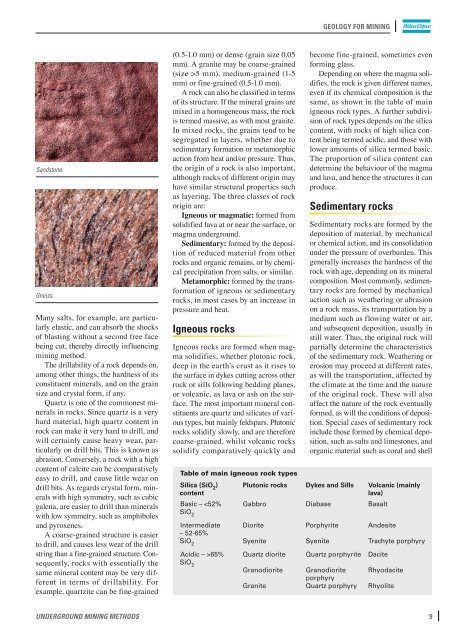Mining_Methods_UnderGround_Mining - Mining and Blasting
Mining_Methods_UnderGround_Mining - Mining and Blasting
Mining_Methods_UnderGround_Mining - Mining and Blasting
Create successful ePaper yourself
Turn your PDF publications into a flip-book with our unique Google optimized e-Paper software.
S<strong>and</strong>stone.<br />
Gneiss.<br />
Many salts, for example, are particularly<br />
elastic, <strong>and</strong> can absorb the shocks<br />
of blasting without a second free face<br />
being cut, thereby directly influencing<br />
mining method.<br />
The drillability of a rock depends on,<br />
among other things, the hardness of its<br />
constituent minerals, <strong>and</strong> on the grain<br />
size <strong>and</strong> crystal form, if any.<br />
Quartz is one of the commonest minerals<br />
in rocks. Since quartz is a very<br />
hard material, high quartz content in<br />
rock can make it very hard to drill, <strong>and</strong><br />
will certainly cause heavy wear, particularly<br />
on drill bits. This is known as<br />
abrasion. Conversely, a rock with a high<br />
content of calcite can be comparatively<br />
easy to drill, <strong>and</strong> cause little wear on<br />
drill bits. As regards crystal form, minerals<br />
with high symmetry, such as cubic<br />
galena, are easier to drill than minerals<br />
with low symmetry, such as amphiboles<br />
<strong>and</strong> pyroxenes.<br />
A coarse-grained structure is easier<br />
to drill, <strong>and</strong> causes less wear of the drill<br />
string than a fine-grained structure. Con-<br />
sequently, rocks with essentially the<br />
same mineral content may be very dif-<br />
ferent in terms of drillability. For<br />
example, quartzite can be fine-grained<br />
(0.5-1.0 mm) or dense (grain size 0.05<br />
mm). A granite may be coarse-grained<br />
(size >5 mm), medium-grained (1-5<br />
mm) or fine-grained (0.5-1.0 mm).<br />
A rock can also be classified in terms<br />
of its structure. If the mineral grains are<br />
mixed in a homogeneous mass, the rock<br />
is termed massive, as with most granite.<br />
In mixed rocks, the grains tend to be<br />
segregated in layers, whether due to<br />
sedimentary formation or metamorphic<br />
action from heat <strong>and</strong>/or pressure. Thus,<br />
the origin of a rock is also important,<br />
although rocks of different origin may<br />
have similar structural properties such<br />
as layering. The three classes of rock<br />
origin are:<br />
Igneous or magmatic: formed from<br />
solidified lava at or near the surface, or<br />
magma underground.<br />
Sedimentary: formed by the deposition<br />
of reduced material from other<br />
rocks <strong>and</strong> organic remains, or by chemical<br />
precipitation from salts, or similar.<br />
Metamorphic: formed by the transformation<br />
of igneous or sedimentary<br />
rocks, in most cases by an increase in<br />
pressure <strong>and</strong> heat.<br />
igneous rocks<br />
Igneous rocks are formed when mag-<br />
ma solidifies, whether plutonic rock,<br />
deep in the earth’s crust as it rises to<br />
the surface in dykes cutting across other<br />
rock or sills following bedding planes,<br />
or volcanic, as lava or ash on the sur-<br />
face. The most important mineral con-<br />
stituents are quartz <strong>and</strong> silicates of various<br />
types, but mainly feldspars. Plutonic<br />
rocks solidify slowly, <strong>and</strong> are therefore<br />
coarse-grained, whilst volcanic rocks<br />
solidify comparatively quickly <strong>and</strong><br />
geOlOgy FOr <strong>Mining</strong><br />
become fine-grained, sometimes even<br />
forming glass.<br />
Depending on where the magma soli-<br />
difies, the rock is given different names,<br />
even if its chemical composition is the<br />
same, as shown in the table of main<br />
igneous rock types. A further subdivision<br />
of rock types depends on the silica<br />
content, with rocks of high silica content<br />
being termed acidic, <strong>and</strong> those with<br />
lower amounts of silica termed basic.<br />
The proportion of silica content can<br />
determine the behaviour of the magma<br />
<strong>and</strong> lava, <strong>and</strong> hence the structures it can<br />
produce.<br />
Sedimentary rocks<br />
Sedimentary rocks are formed by the<br />
deposition of material, by mechanical<br />
or chemical action, <strong>and</strong> its consolidation<br />
under the pressure of overburden. This<br />
generally increases the hardness of the<br />
rock with age, depending on its mineral<br />
composition. Most commonly, sedimentary<br />
rocks are formed by mechanical<br />
action such as weathering or abrasion<br />
on a rock mass, its transportation by a<br />
medium such as flowing water or air,<br />
<strong>and</strong> subsequent deposition, usually in<br />
still water. Thus, the original rock will<br />
partially determine the characteristics<br />
of the sedimentary rock. Weathering or<br />
erosion may proceed at different rates,<br />
as will the transportation, affected by<br />
the climate at the time <strong>and</strong> the nature<br />
of the original rock. These will also<br />
affect the nature of the rock eventually<br />
formed, as will the conditions of deposition.<br />
Special cases of sedimentary rock<br />
include those formed by chemical deposition,<br />
such as salts <strong>and</strong> limestones, <strong>and</strong><br />
organic material such as coral <strong>and</strong> shell<br />
Table of main igneous rock types<br />
Silica (SiO2 )<br />
content<br />
Plutonic rocks Dykes <strong>and</strong> Sills Volcanic (mainly<br />
lava)<br />
Basic – 65% Quartz diorite Quartz porphyrite Dacite<br />
SiO 2<br />
Granodiorite Granodiorite Rhyodacite<br />
porphyry<br />
Granite Quartz porphyry Rhyolite<br />
underground mining methods 9
















